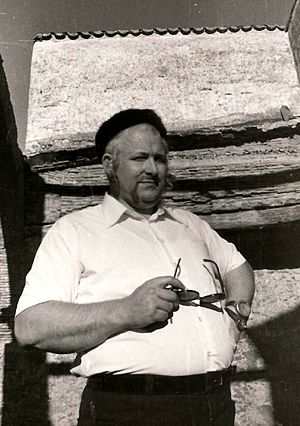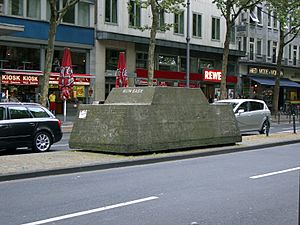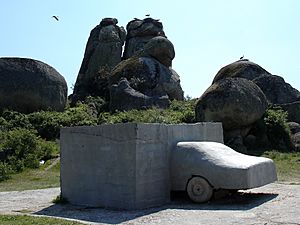Wolf Vostell facts for kids
Quick facts for kids
Wolf Vostell
|
|
|---|---|

Wolf Vostell, 1980
|
|
| Born | 14 October 1932 Leverkusen, Germany
|
| Died | 3 April 1998 (aged 65) Berlin, Germany
|
| Nationality | German |
| Education | Kunstakademie Düsseldorf |
| Known for | Painting Sculpture Installation art Video art Dé-collage |
| Movement | Happening Fluxus |
| Spouse(s) | Mercedes Vostell |
Wolf Vostell (born October 14, 1932 – died April 3, 1998) was a German artist. He was a painter and sculptor. Many people see him as one of the first artists to use video art and installation art. He also helped start the Happening and Fluxus art movements.
Vostell was known for special art techniques. These included blurring and Dé-coll/age. He also put everyday objects, like cars, into concrete. He often used television sets in his artworks. Wolf Vostell was married to the Spanish writer Mercedes Vostell. They had two sons, David Vostell and Rafael Vostell.
Contents
Wolf Vostell's Life and Art
Wolf Vostell was born in Leverkusen, Germany. He started creating art in 1950. In 1953, he learned how to be a lithographer. This is someone who makes prints using a special stone or metal plate. He also studied art in Wuppertal, Paris, and Düsseldorf.
What is Dé-coll/age?
In 1954, Vostell created his first Dé-coll/age. He got the idea from a newspaper headline about a plane crash. The word "décollage" means to "unstick" or "take apart." Vostell used this idea to tear down posters. He also used pieces of real-life objects in his art. For Vostell, Dé-coll/age was about breaking old ideas. It made people think differently about media.
Early Art Events: Happenings
In 1958, Vostell held his first Happening in Paris. A Happening is a type of art event. It often involves the audience and happens in a specific time and place. His Happening was called The Theater is in the Street. It used car parts and a TV.
In 1959, he started making electronic TV Dé-coll/age art. This was after he saw the work of Karlheinz Stockhausen, a composer.
Joining the Fluxus Movement
Vostell helped start the Fluxus art movement in 1962. Fluxus was a group of artists. They liked to mix different art forms. They used music, poetry, and everyday objects. Vostell held many Happenings in cities like New York and Berlin. In 1962, he joined other famous artists like Nam June Paik in a Fluxus festival.
Pioneering Video and Installation Art
In 1963, Wolf Vostell became a leader in video art and installation art. His work 6-TV-Dé-coll/age was shown in New York. It is now in a museum in Madrid. This art piece used multiple televisions. Vostell was the first artist to put a TV set into an artwork. His 1958 installation The black room is an example.
Art About Important Topics
Vostell often used his art to talk about important world events. For example, his 1967 Happening Miss Vietnam was about the Vietnam War. He also created art about the fall of the Berlin Wall. He made over 50 works on this topic.
Sculptures with Cars and Concrete
Wolf Vostell is famous for his sculptures made from cars and concrete.
- Ruhender Verkehr (Stationary traffic) from 1969 is in Cologne.
- Concrete Traffic from 1970 is in Chicago.
- VOAEX from 1976 is in the Museo Vostell Malpartida in Spain.
- Zwei Beton-Cadillacs in Form der nackten Maja from 1987 is in Berlin.
These sculptures show how Vostell liked to use everyday objects in surprising ways. He wanted people to see familiar things differently.
Collaborating with Salvador Dalí
In 1978, Vostell met the famous artist Salvador Dalí. They worked on a project together in 1988. Dalí had an idea for a sculpture using bicycles. Vostell changed it to use 20 motorcycles. In return, Vostell put his TV-Obelisk sculpture in Dalí's museum. Dalí added a woman's head to the top.
Later Life and Legacy
In 1992, the city of Cologne held a big show of Vostell's art. His son, David Vostell, made a film about it. Wolf Vostell passed away in 1998. He is buried in Madrid, Spain.
Vostell's Artistic Style
Dé-coll/age and Blurring Techniques
Vostell's Dé-coll/age technique involved tearing or cutting images. He would often use posters. This created new, layered images. Examples include Rue de Buci (1960) and Coca-Cola (1961).
He also used a technique called blurring. He would use chemicals to blur photographs in magazines. This made the images look hazy or distorted. Goethe Today (1967) and Homage to Henry Ford and Jaqueline Kennedy (1967) are examples. He sometimes combined blurring with Dé-coll/age.
Using Television in Art
Since 1958, Wolf Vostell often put television sets into his artworks. He used them in paintings, sculptures, and installations. The TVs were usually set to show normal programs. This meant his art changed with the news and current events.
Concrete, Lead, and Gold
Vostell started working with concrete in the early 1960s. It became a key part of his art. He made large sculptures from concrete. He also used liquid concrete like paint on his canvases. His paintings often show concrete blocks or human figures shaped like concrete.
Later, in the 1980s and 1990s, he also used liquid lead and gold leaf. He would pour liquid lead over his paintings. He also added thin sheets of gold to his canvases.
Wolf Vostell Archive
In the 1960s, Vostell started the Vostell Archive. He collected many things related to art. This included photos, art writings, and letters with other artists. He also kept newspaper clippings, invitations, and books. This archive shows his own work and the work of other artists from his time.
His personal library, with over 6,000 books, is part of the archive. The archive has about 50,000 documents. It is a valuable resource for people who study art history. Since 2005, the archive has been at the Museo Vostell Malpartida in Spain. It is open to art historians and students.
Selected Works
- Korea Massaker, 1953
- Das schwarze Zimmer (The black room), 1958, Installation with TV, Berlinische Galerie, Berlin
- Das Theater ist auf der Straße (The theater is on the street), 1958, Happening
- Rue de Buci, 1960, Dé-coll/age
- Coca-Cola, 1961, Dé-coll/age, Ludwig Museum, Köln
- 6 TV Dé-coll/age, 1963, Installation, Museo Nacional Centro de Arte Reina Sofía, Madrid
- Sun in your head, 1963, Video
- Goethe Heute, 1967, Sprengel Museum Hannover
- Hommage an Henry Ford und Jaqueline Kennedy, 1967, Installation, Ludwig Museum
- Elektronischer Dé-coll/age Happening Raum, 1968, Installation with TV, Neue Nationalgalerie, Berlin
- Ruhender Verkehr, 1969, Hohenzollernring, Köln
- Concrete Traffic, 1970, Chicago
- Heuschrecken, 1970, Museum Moderner Kunst, MUMOK, Vienna
- Auto-Fieber, 1973, Installation, Museo Vostell Malpartida
- VOAEX, 1976
- Zwei Beton-Cadillacs in Form der nackten Maja, 1987, Rathenauplatz, Berlin
- Schule von Athen, 1988, LVR-LandesMuseum, Bonn
- 9. November 1989 Berlin, 1989
- Auto-TV-Hochzeit, 1991, Zentrum für Kunst und Medientechnologie, Karlsruhe
- Jesus mit TV Herz, 1996
Famous Quotes
- "Art is Life, Life is Art." (1961)
- "Events are weapons to politicize art." (1970)
- "I declare peace the greatest work of art." (1979)
- "Every human being is a work of art." (1985)
Awards and Honours
Wolf Vostell received many awards for his art:
- 1982: Premio Pablo Iglesias, Madrid.
- 1990: Médaille de la Ville de Paris (Medal from the City of Paris)
- 1992: Honorary professorship, Berlin.
- 1996: Berlin Bear (B.Z. Culture Prize)
- 1997: Hannah Höch Prize.
- 1998: Medalla de Extremadura, Spain (given after his death)
- A street in Malpartida de Cáceres, Spain, is named Paseo Wolf Vostell.
- He was made an honorary citizen of Malpartida de Cáceres, Spain.
- 2001: Wolf Vostell Strasse, Leverkusen (named after his death)
- 2014: International Human Rights Award, Dr. Rainer Hildebrandt Medal (given after his death)
See also
 In Spanish: Wolf Vostell para niños
In Spanish: Wolf Vostell para niños
- Installation art
- Video art
- Happening
- Fluxus
- Conceptual art




